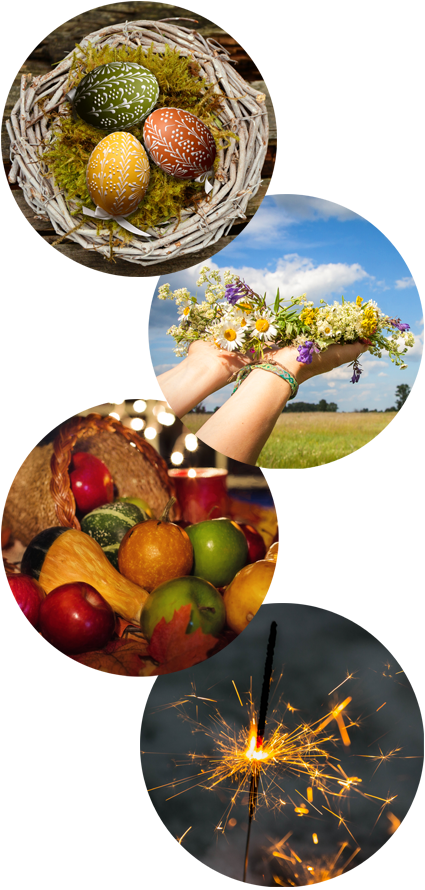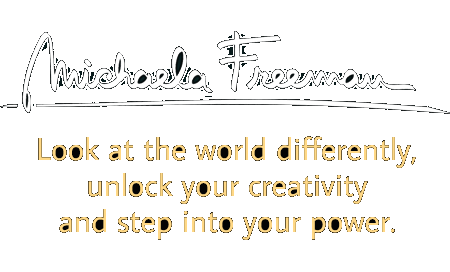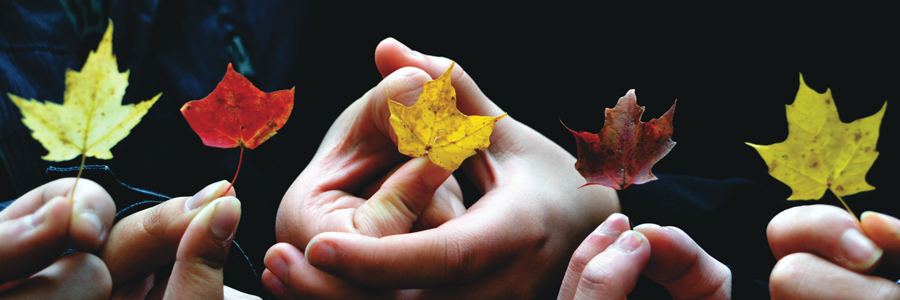Modern industrial society reduced rituals to weddings and funerals, which is a shame. For millennia, ceremonies marked all significant changes and decisions in people’s lives. They are powerful milestones of our personal and spiritual development. I’m trained to provide tailor-made modern
Modern Rituals & Ceremonies
Many people are dissatisfied with the industrial-age idea of a wedding or a funeral and search for new and more meaningful forms of conducting ceremonies. I was one of them, and couldn’t imagine the pressure of organizing the wedding everyone expected. So, we did it our
We separated our wedding into two parts on different dates – the legal part which was held at local municipality with my sister and brother-in-law as witnesses, and the ceremonial part that was held in a house in the midst of nature, with friends and family. I wrote the speech delivered by our close friend, we did hand-tying instead of exchanging rings, my dress was peacock blue, I baked my own wedding cake and cooked most of the food. People camped in tents and we had a big barbecue. You don’t have to follow the rules, particularly not on the day that’s supposed to be yours.
But there are many more occasions that deserve a proper ceremony. Our soul craves rituals, both the small personal ones we do every day (like drinking your coffee from a favorite mug) and the large ones that mark special occasions. We forgot this and we are emotionally starving. We are afraid of some woo-woo stuff we don’t understand. We don’t like the idea of a stiff prescribed structure of meaningless steps with high expectations. But it doesn’t have to be this way.
While traditional rituals are usually built around a strict order of events, modern rituals leave some “space for miracles” and remain more flexible. Modern ceremonies are custom-designed for the people involved. They also go with the flow. If someone feels too touched or overwhelmed to speak, we wait. If someone needs an extra long hug, the better.
Non-Religious Rituals, Even for Atheists
Rituals are personal spiritual experiences and as such, they are mystical, not religious in nature. This makes modern rituals comprehensible even to novices and far less stressful. We expect participants to play a role, to have “direct dial to the universe” and enjoy their own experiences. Yes, I can lead the ritual, but it’s not about authority. The role is similar to a conductor of an orchestra, everyone still needs to play their instrument. I can also simply help you design your own ceremony and someone else can be the conductor.
They are non-denominational and multicultural in nature, which means that we can bring together people from an international business team or from diverse ethnic or religious backgrounds and still provide them with a meaningful sense of connection.
Modern rituals and ceremonies are fully understandable to atheists. They don’t need to celebrate any particular god or deity, they focus on the three things we all have in common:
- connection to our own spirit (our inner self, higher self, soul – however you call it) – hence spirituality, not
religion ; - connection to our environment – celebrating nature, changes of season, natural cycles, and understanding ourselves within the bigger-picture;
- connection to one another – fulfilling the social role of deepening ties between couples, friends, families or communities.
My Modern-Ceremonialist Training

In 2018, I completed my non-denominational ceremonialist training with Lilia Khousnoutdinová and her team. The unofficial title is Priestess of Ancient Europe, even though this is not a religious school. It’s closer to the idea of ancient-Greek oracles, the Roman Vestals, and particularly our own tradition of Libuše, an oracle Pagan Princess, the founder of the first lineage of Czech Kings.
But all that is just an inspiration. We explored the ways people do rituals in many cultures but mainly focused on our own roots in the Pre-Christian Central-European spirituality – meaning Celtic and Slavic. You could call it Neo-Pagan, but I prefer to simply call it modern – very open-minded, non-dogmatic and internationally connected.
As with all my work, I love to bridge different influences, polarities, cultures, and approaches. But after some 30 years of my own spiritual learning and practice, where I touched on many philosophies and worldwide religions, it was time for me to acknowledge the simple facts that I’m a woman and I was born in the heart of Europe.
Many people go to study spirituality in India. I felt that this offers plenty of mysteries to explore and a unique mix of influences from both East and West. Hence my spiritual practice should align with the concept of being a female ceremonialist (a priest-ess – which is only unusual because most religions remain lead by men), and with this particular territory, with the rhythms of nature as we have them here.
Objectively, I still probably know more about shamanism, Hinduism or Buddhism, but I felt this training beautifully completed a part of my own journey and provided me with the grounding in my own land of origin, while respecting my individual path.
The Timeless Zone
If you attend a wedding in a foreign country, you may not understand the meaning of each step, but you fully sense the transformation taking place. You can sense how special and important that moment is. The bride and groom step into a designated sacred space, make their decision and step out as wife and husband. What happened at the altar (or under an o tree, or in a temple…) is profound and to them seems timeless.
This access to the ‘timeless zone’ is the main purpose of each ritual. You leave the old self behind the threshold, temporarily enter the zone of mystical transformation, and come back as someone new. It’s actually that simple, but utterly profound.
The Power of Rituals
For example, nearly every culture except our industrial one marks the transition into adulthood with a rites-of-passage ritual. They are different in style, but the idea is always the same. It’s an acknowledgment by the young person’s family and community that from now on they will be treated differently, they gain certain rights and responsibilities.
For girls, this ritual typically comes with their first period, celebrating the moment when they physically become women. In our society, girls are ashamed of it instead, hiding what should be celebrated, and as a result, physically suffering during their periods.
In my case, I cumulatively spent 7 years of my life on pink pills, until I was 43 and I went through the Menarché ritual I should have had as a teenager. Since then – inner peace, a sense of power and no physical pain. When I talk about the power of rituals, I mean POWER. I mean mind over matter.
Cycles of Nature and Power of Elements

I found that regardless of cultural and religious backgrounds, people are always able to easily connect to two basic principles – cycles of nature and natural elements. It simply makes sense to me to celebrate the oncoming spring, express gratitude for a year’s harvest or take note of the longest night of the year.
Earth, water, fire
- We use fire to burn what we don’t want (e.g. a paper with a personal statement) and to light candles that bring
spark to our lives. - Water lends itself to cleansing and to symbolically making a toast and sipping from a ritual chalice.
- Aside from actual burials, we can also symbolically bury in earth anything we don’t want in our
lives, or plant seeds of what we do. - The proverbial wind of change is often represented by cleansing smoke or
insence , as well as festive baloons celebrating an event.
I find it fascinating that cultures around the world developed similar customs and symbolism for rituals, ceremonies, and celebrations. There are countless variations, but the principles are the same. I learned to custom-design rituals based on the needs of each client, their family or community. The ultimate goal is a beautiful uplifting experience that brings our life stages or decisions to our full consciousness, acknowledges and celebrates them.
The Esthetic of Modern Rituals
When I say modern, I also mean that esthetically, rituals don’t necessarily have to look ‘hippie’ or archaic. The choice of location, decoration, clothing, and ceremonial accessories will set the tone of the event. If you are a high-tech company where most people view spirituality through the lens of the Jedi Order from Star Wars, rather than beads and crystals, I get it.
The good news is that we can design it however we want. We don’t have to blindly follow traditions, we are as capable as our ancestors to establish new ones. This one may be a difficult concept for many people. Let me stress this – our ancestors were equally equipped to invent ways to celebrate, acknowledge and express their spirituality and connection to nature and one another. We have every right to invent our own ways that are relevant to our world. The more inventive we get, the more personal and meaningful the experience.
Types of Modern Rituals
My priestess training covered all life-stage rituals and ceremonies that we could (or should!) have:
- Welcoming a newborn and name-giving
- Going to school / back-to-school (many people do a ritual for kids
in the beginning of each school year) - Rites-of-passage for teenage girls and boys (Menarché ritual for girls who get their first period, boys’ rituals should be organized by men)
- Pre-wedding ritual (usually the bride and groom separately with their friends – a meaningful alternative to thoughtless stag and hen parties)
- Wedding
- A ritual for couples planning to conceive a child
- Pre-birthing ritual for the new mother (not a “baby shower” but a “mother shower”)
- After-birthing ritual for the new mother (an often forgotten “thank you”) and/or baby-welcome or naming
- A divorce ritual (again, something brushed over in
a society despite being a fundamental experience for the two people) - Menopause ritual for women and/or going-to-retirement ritual for men and women
- Help in dying and funeral ceremony
I don’t provide these rituals as a service because my fellow priestesses are much more focused on this type of work and family gatherings. Many particularly work with the female cycle as a major theme and run courses or women’s circles. I focus on that’s close to my heart: nature, healing, creativity, and transformation. I can design rituals for example around these subjects:
- Celebrations of nature cycles (seasons, solstice/equinox, full moon, planting, harvest, etc.)
- Launching creative and entrepreneurial projects or new products
- Building cohesion in a creative or business team
- Welcoming a new team member / Good-bye ritual for a leaving team member
- Transformations / Overcoming a personal problem (letting go of the old self, cutting off what doesn’t serve anymore, quitting smoking)
- Making career changes
- Blessing a new home or business facility
- Preparation for a journey, travel or moving away
To me, all such occasions are worth acknowledging on a deeper level. A ritual provides the personal and public space in which to bring closure to certain life stages, mourn our losses and loudly state our intents and hopes for the future. This makes us remember that our decisions were conscious, that our intents were real. Seasonal celebrations are perfect moments to pause in our busy lives and reflect on where we are. To me, this is a natural part of life and without these milestones, life loses its richness and direction.
Rituals as a Service
Rituals are not my main activity but I still enjoy leading them. I participate in organizing or personally organize some rituals, typically seasonal celebrations, that are accessible for free, usually with the expectation that participants bring along some food or drinks for everyone to share.
If I am to custom-design a ritual for an individual, a family or a team, it’s a job like any other, requiring organizational meetings, planning, equipment and travel that need to be covered. The price depends on the scope of the event, but in essence, it’s a similar process as wedding planning or company event organization. Rituals are not exactly parties but require about the same amount of effort. Plus some extra magic.
Cover image by Pexels from Pixabay Easter eggs by congerdesign from Pixabay Summer wreath by Nadine Zarya from Pixabay Cornucopia by Jill Wellington from Pixabay Sparkler by Gabriel Greuter from Pixabay

